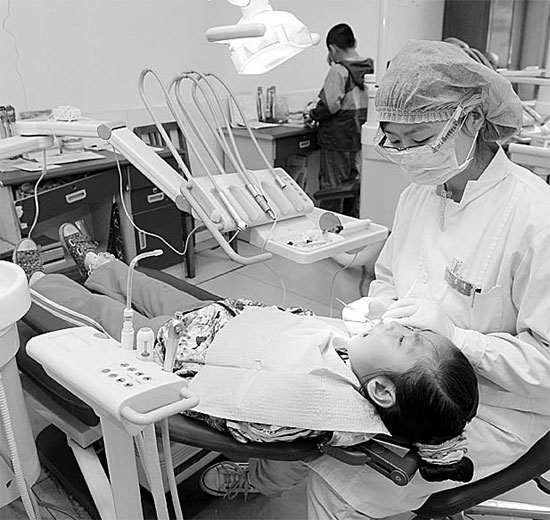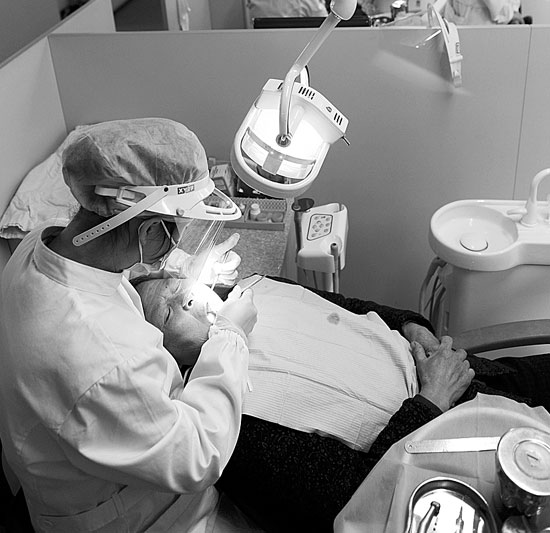Chinese face up to need for brighter smiles
Updated: 2014-02-06 08:20
By Gao Changxin in Shanghai (China Daily USA)
|
||||||||
Braces get lighter and more comfortable, prompting many younger people to pay the price for feeling more attractive and improving their image at work
Gaining "face" for face-loving Chinese no longer means merely carrying a Louis Vuitton bag, driving a brand-new Ferrari or getting the latest iPhone.
It's gotten more literal.
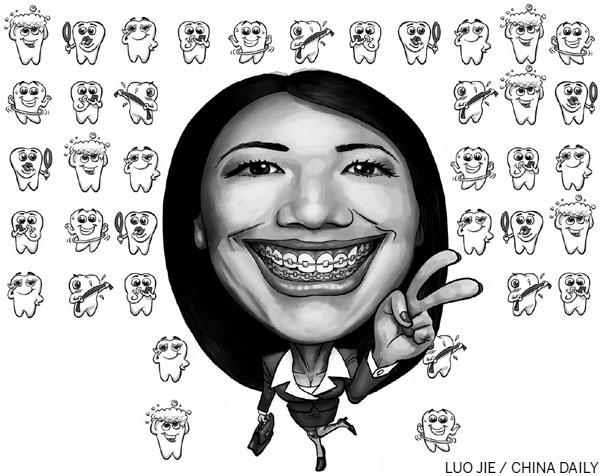
As well-off Chinese mingle with their counterparts elsewhere in the world through travel and studying abroad, many have come to realize that nothing damages their "face" more than a mouthful of crooked teeth.
Deep-pocketed dental upstarts have been quick in providing a remedy. And today it's not usual to see adults strolling around confidently in downtown shopping malls wearing shiny orthodontic braces.
In the new super-chic iAPM Mall that opened last year on Shanghai's downtown Haihuai Road, 28-year-old Chang Yue voiced regrets that she hadn't straightened her teeth as a teenager.
"Few people knew then that having white, straight teeth could be so important - definitely not my parents. It takes more time to do it now, but it's still worth it," she said.
Chang, a successful saleswoman for a multinational drug company in Shanghai, got the courage to undertake the three-year course of orthodontic work after observing one of her colleagues.
She said that she was "deeply impressed" with the improvement in her colleague's smile. And experience from work made her realize how a gleaming smile could improve her presentations when dealing with international clients.
Chang is six months into her orthodontic treatment. The entire program will cost 20,000 yuan ($3,294), which is at the lower end of the price spectrum for orthodontic treatments in Shanghai.
"I have faith that the money will be well spent," she said.
Chang is one of the many young adults in China who are making regular visits to orthodontic clinics that they didn't have the awareness or resources to visit when they were teenagers.
A recent survey of 240 Chinese undergraduate students at the University of Hong Kong aged 18 to 27 found that 47 percent of them had moderate orthodontic treatment needs and another 33 percent had great or very great treatment needs.
The three most common reasons given for participants seeking orthodontic treatment were to improve their appearance, self-image and self-confidence.
According to the China Dental Industry Report (2012-2014), provided by Researchandmarkets.com, the scale of the dental equipment market in China surged by 31.6 percent year-on-year in 2011 to 2.59 billion yuan. But China still lags far behind its developed-nation counterparts in the dental equipment field.
The proportion of adults among all orthodontic treatment patients in China has grown from 10 percent to 20 percent a decade ago to 30 percent at present.
Driven by the increasing awareness of dental health, orthodontics and dental implants will help the industry maintain a 20 to 30 percent annual growth rate, according the report.
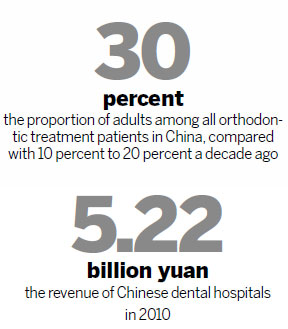
The report estimates that the number of implanted teeth will soar to 500,000 in the coming five years from 100,000 at present.
Thanks to the buoyant advance of the dentistry market, Chinese dental hospitals are expected to see continued vibrant growth.
In 2010, the revenue of Chinese dental hospitals totaled 5.22 billion yuan, with the growth rate averaging 21.8 percent from 2006 to 2010.
The gross margin was at a high level of about 11 percent in the three years to 2010.
Dentist Tommy Ma, founder of Jsmile Dental in Shanghai, said he has been seeing an increasing number of Chinese patients over the past few years.
"Slowly but surely, Chinese people are becoming more aware of their smiles, but the gap is still wide with developed countries such as the United States," said Ma.
He owned and operated a dental clinic in Atlanta in the United States for six years before moving his practice to Shanghai in 2010.
Ma started out in Shanghai mostly serving expatriates in the city, who are more willing to visit dentists than their Chinese counterparts.
But today, Chinese customers make up a substantial part of his client base and his clinic is preparing an ad campaign that specifically targets Chinese patients.
At the moment, most of the Chinese customers coming to Ma's clinic are there to get their teeth straightened, but few do regular check-ups like their American counterparts.
"Chinese people view dental care as a one-time thing. They come to us only when their teeth hurt or need straightening.
"In the US, people see dental care as a lifetime routine and have regular dental exams," said Ma.
The situation in China is improving, he added, especially in big cities such as Shanghai and Beijing, with more people visiting dentists regularly. But it's going to take a long time before the situation in China is comparable with that in the US.
Fear is a key reason why Chinese people are reluctant to see dentists. Others are awareness and healthcare coverage, he said.
Chang Yunping, an orthodontist with the Shanghai Stomatological Disease Center, said that unpleasant childhood experiences with dental treatment can evolve into a fear of seeking treatment as an adult.
"That's especially true in China, where dental services were extremely primitive and painful 20 years ago," said Chang.
A 2006 study in Australia by the University of Adelaide found that 16.4 per cent of adults and 10.3 per cent of children feared dental treatment, with females more likely to be scared.
"It was indeed a horrible experience pulling out teeth at the hospital when I was a kid. It hurt so bad that my whole face was swollen," said 27-year-old Li Jie, an office clerk in Shanghai.
"I wouldn't say that will stop me from going to dentists. I still go if my gums are bleeding. But if I feel fine, I probably wouldn't want to go."
Part of the reason why an increasing number of adults in China are deciding to get braces is that advances in orthodontic technology have made the treatment less painful and noticeable.
One of the top reasons why many adults have avoided braces is because the traditional "train tracks" are bulky and uncomfortable. Ceramic braces today are of a similar color to teeth and so less noticeable. They're also much smaller, which increases the level of comfort.
The latest type of orthodontic brace is called Invisalign, a treatment that relies on sets of clear, removable teeth aligners used as an alternative to traditional metal dental braces.
The aligners are completely transparent and far less detectable than traditional wire and bracket braces. That's helped them gain popularity among adults who want to straighten their teeth without the look of traditional metal braces.
The aligners are also more comfortable than braces because the device's removable nature means that food can be consumed without the encumbrance of metallic braces.
Jsmile's Ma said that Invisalign, which costs about 60,000 yuan, is the top choice for adults at his clinic wanting to have their teeth straightened.
gaochangxin@chinadaily.com.cn
|
A dentist at work in the Yinchuan Stomatological Hospital in Ningxia Hui autonomous region. Wang Peng / Xinhua |
|
A woman undergoes dental treatment at a hospital in Dongyang, Zhejiang Province. Bao Kangxuan / For China Daily |
(China Daily USA 02/06/2014 page15)

 Chinese Lunar New Year gift from abroad
Chinese Lunar New Year gift from abroad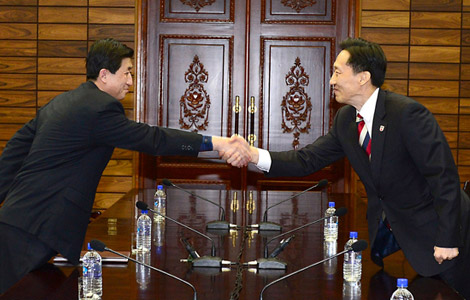
 Koreas reach out for family reunions
Koreas reach out for family reunions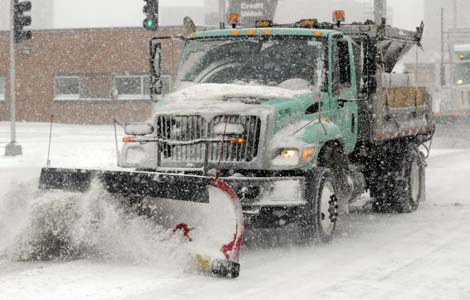
 Storm to slam two-thirds of US
Storm to slam two-thirds of US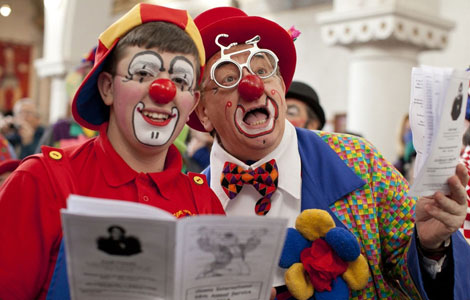
 Clowns gather for Joseph Grimaldi celebration
Clowns gather for Joseph Grimaldi celebration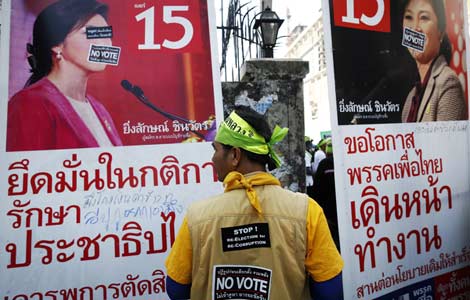
 Thai caretaker PM urges protesters not to block voting
Thai caretaker PM urges protesters not to block voting
 Holy waters in Nepal
Holy waters in Nepal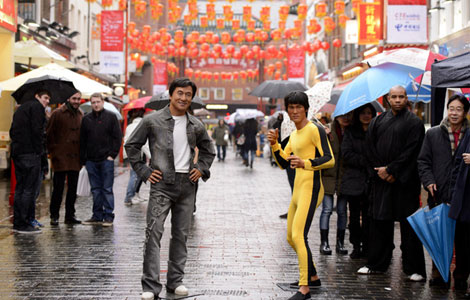
 Kongfu stars wax shine in London ChinaTown
Kongfu stars wax shine in London ChinaTown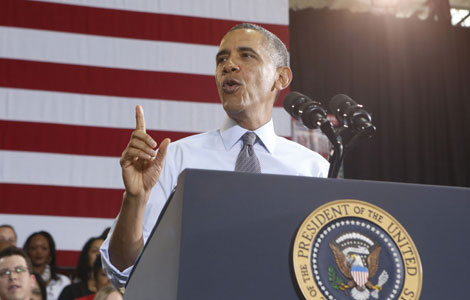
 Obama pushes minimum wage hike
Obama pushes minimum wage hike
Most Viewed
Editor's Picks

|
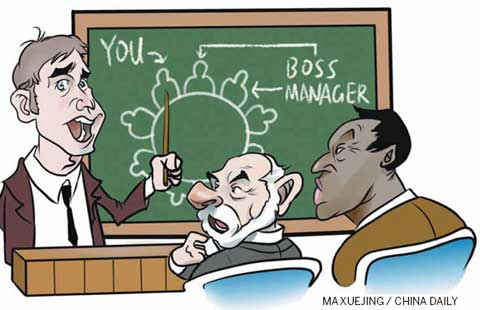
|

|

|
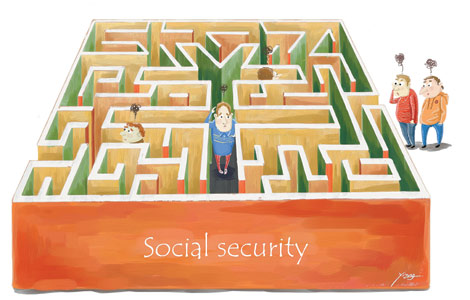
|

|
Today's Top News
Xi leaves for Sochi ceremony Thursday
China to bid on troubled Brazilian dam project
Flying Tigers denounce Abe's visit
China's oil demand is growing
Schroeder accuses US of disrespect
US criticism over ADIZ unfounded
US warns airlines about 'toothpaste bombs'
Family's murder leaves few clues
US Weekly

|

|
